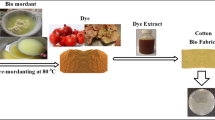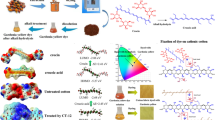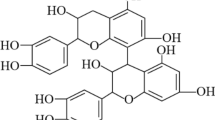Abstract
Natural fiber-made apparel dyed with natural dyes is drawing consumer attention because of the possible toxic and health hazards associated with fabric dyed with synthetic dyes. However, many textile products dyed with natural dyes available in the market could pose a health risk because of the use of toxic heavy metals as a dye-complexing agent. In this work, jute fabrics were dyed and multi-functionalized with gallotannin (GT), using ferrous sulfate (FeSO4), calcium chloride (CaCl2), and aluminum chloride (AlCl3) as a non-toxic mordanting agent. The shades produced and other physicochemical properties of the GT-dyed jute fabrics were compared with the jute fabric treated with GT using copper sulfate (CuSO4), a common mordanting agent. It was found that the GT with various mordanting agents produced navy blue and brown shades with tonal changes along with quite good colorfastness to washing. The concentration of GT and mordanting agents, types of mordanting agents, and the treatment pH affected the shade produced and physicochemical properties of the treated fabrics. The surface resistivity was reduced from 235 × 1010 Ω/sq for the control to 6.7 × 1010 Ω/sq for the AlCl3 mordanting agent, slightly higher than the surface resistivity exhibited by the CuSO4 mordant. The fabric treated with GT using FeSO4 and CaCl2 mordanting agents showed excellent antioxidant activity, even at the lowest GT dosage applied. Similarly, FeSO4 and CaCl2 also showed excellent UV radiation absorption capability. The developed treatment can be used in the textile industry to make cellulosic textiles multifunctional without using any toxic dyes and chemicals.
Graphic abstract









Similar content being viewed by others
References
Ali A, Ali S, Saleem H, Hussain T (2010) Effect of tannic acid and metallic mordants on the dyeing properties of natural dye extracted from Acacia nilotica bark. Asian J Chem 22:7065–7069
Bismarck A, Mohanty A, Hinrichsen G, Khan M (2000) Characterization of several modified jute fibers using zeta-potential measurements. Colloid Polym Sci 278:229–235
Burkinshaw SM, Kumar N (2009) The mordant dyeing of wool using tannic acid and FeSO4, Part 1: initial findings. Dye Pigment 80:53–60
Chakraborty JN (2014) Dyeing of silk. Fundamentals and practices in coloration of textiles, 2nd edn. Woodhead Publishing India, Delhi, pp 262–270
Chattopadhyay SN, Pan NC, Roy AK, Khan A (2014) Dyeing of jute fabric with natural dye extracted from annatto. AATCC J Res 1:20–27
Chattopadhyay SN, Pan NC, Roy AK, Khan A (2015) Sustainable coloration of jute fabric using natural dyes with improved color yield and functional properties. AATCC J Res 2:28–36
Del Río JC, Rencoret J, Marques G, Li J, Gellerstedt G, Jesús J-B, Martínez AT, Gutiérrez ANA (2009) Structural characterization of the lignin from jute (corchorus capsuiaris) fibers. J Agric Food Chem 57:10271–10281
Deo HT, Desai BK (1999) Dyeing of cotton and jute with tea as a natural dye. Col Technol 115:224–227
Djakpo O, Yao W (2010) Rhus chinensis and Galla Chinensis-folklore to modern evidence: review. Phytother Res 24:1739–1747
Falcão L, Araújo MEM (2014) Application of ATR-FTIR spectroscopy to the analysis of tannins in historic leathers: the case study of the upholstery from the 19th century portuguese royal train. Vib Spectrosc 74:98–103
Flora SD (2000) Threshold mechanisms and site specificity in chromium (VI) carcinogenesis. Carcinogenesis 21:533–541
Ghigo G, Berto S, Minella M, Alladio E, Nurchi VM, Lachowicz J, Daniele PG (2018) New insights into the protogenic and spectroscopic properties of commercial tannic acid: the role of gallic acid impurities. New J Chem 42:7703–7712
Gooch JW (2011) Whiteness index. In: Gooch JW (ed) Encyclopedic dictionary of polymers. Springer, New York, NY
Grifoni D, Bacci L, Di Lonardo S, Pinelli P, Scardigli A, Camilli F, Sabatini F, Zipoli G, Romani A (2014) UV protective properties of cotton and flax fabrics dyed with multifunctional plant extracts. Dyes Pigment 105:89–96
Hassan MM (2020) Enhanced thermal stability, hydrophobicity, UV radiation resistance, and antibacterial properties of wool fabric treated with p-aminobenzenesulfonic acid. RSC Adv 10:17515–17523
Hassan MM, Hawkyard CJ (2002) Reuse of spent dyebath following decolorization with ozone. Color Technol 118:104–111
Hassan MM, Saifullah K (2019) Effect of enzymatic bio-scouring on the dyeability, physicochemical, and mechanical properties of jute fabrics. Fiber Polym 20:578–587
Hassan MM, Shao J (2016) Chemical processing of wool: sustainability considerations. Key Eng Mater 671:32–39
Huang X-L, Liu M-D, Li J-Y, Zhou X-D, ten Cate JM (2012) Chemical composition of Galla chinensis extract and the effect of its main component(s) on the prevention of enamel demineralization in vitro. Int J Oral Sci 4:146–151
Ibrahim NA, El-Gamal AR, Gouda M, Mahrous F (2010) A new approach for natural dyeing and functional finishing of cotton cellulose. Carbohydr Polym 82(4):1205–1211
Jiang B, Zhang Y, Gu L, Wu W, Zhao H, Jin Y (2018) Structural elucidation and antioxidant activity of lignin isolated from rice straw and alkali-oxygen black liquor. Int J Biol Macromol 116:513–519
Kim H-I, Park S-M (2007) Influence of tannin on dye uptake and wash fastness at dyeing of silk fabric with amur cork tree. J Fiber Sci Technol 63:8–14
Kumar V, Bharti BV (1998) Eucalyptus yields dye. Indian Text J 10:18–20
Lellis B, Fávao-Polonio CZ, Pamphile JA, Polonio JC (2019) Effects of textile dyes on health and the environment and bioremediation potential of living organisms. Biotechnol Res Innov 3:275–290
Nam S, Condon BD, Xia Z, Nagarajan R, Hinchliffe DJ, Madison CA (2017) Intumescent flame-retardant cotton produced by tannic acid and sodium hydroxide. J Anal Appl Pyrolysis 126:239–246
Pan NC, Chattopadhyay SN, Day A (2003) Dyeing of jute with natural dyes. Indian J Fiber Text Res 28:339–342
Pan NC, Chattopadhyay SN, Day A (2004) Dyeing of jute fabric with natural dye extracted from marigold flower. Asian Text J 13:80–82
Pisitsak P, Hutakamol J, Jeenapak S, Wanmanee P, Nuammaiphum J, Thongcharoen R (2016) Natural dyeing of cotton with Xylocarpus granatum bark extract: dyeing, fastness, and ultraviolet protection properties. Fiber Polym 17:560–568
Proctor DM, Otani JM, Finley BL, Paustenbach DJ, Bland JA, Speizer N, Sargent EV (2002) Is hexavalent chromium carcinogenic via ingestion? A weight-of-evidence review. J Toxicol Environ Health A 65:701–746
Romani A, Campo M, Pinelli P (2012) HPLC/DAD/ESI-MS analyses and anti-radical activity of hydrolyzable tannins from different vegetal species. Food Chem 130:214–221
Saravanan D (2007) UV protection textile materials. AUTEX Res J 7:53–62
Togo Y, Komaki M (2010) Lac dyeing cotton fibers by pretreating with tannic acid and aluminum acetate. J Fiber Sci Technol 66:291–298
Zhang H, Liu X, Fu S, Chen Y (2019) High-value utilization of kraft lignin: color reduction and evaluation as sunscreen ingredient. Int J Biol Macromol 113:86–92
Zhao X, Sun H, Hou A, Zhao Q, Wei T, Xin W (2005) Antioxidant properties of two gallotannins isolated from the leaves of Pistacia weinmannifolia. Biochim Biophys Acta 1725:103–110
Zhou Y, Tang R-C (2017) Natural flavonoid-functionalized silk fiber presenting antibacterial, antioxidant, and UV protection performance. ACS Sustain Chem Eng 5:10518–10526
Funding
No funding was received for conducting this study.
Author information
Authors and Affiliations
Corresponding author
Ethics declarations
Conflicts of interest
The authors have no conflicts of interest to declare that are relevant to the content of this article.
Human or animal rights
The work described in this article did not involve human participants and or animals.
Additional information
Publisher's Note
Springer Nature remains neutral with regard to jurisdictional claims in published maps and institutional affiliations.
Supplementary Information
Below is the link to the electronic supplementary material.
Rights and permissions
About this article
Cite this article
Hassan, M.M., Saifullah, K. Sustainable dyeing and functionalization of jute fabric with a Chinese sumac gall-derived gallotannin using eco-friendly mordanting agents. Cellulose 28, 5055–5070 (2021). https://doi.org/10.1007/s10570-021-03805-x
Received:
Accepted:
Published:
Issue Date:
DOI: https://doi.org/10.1007/s10570-021-03805-x




